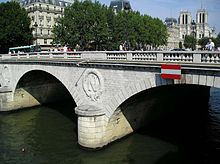Pont Saint-Michel
| Pont Saint-Michel | |
|---|---|

Pont Saint-Michel with Notre-Dame de Paris in the background
|
|
| Coordinates | 48°51′15″N 02°20′41″E / 48.85417°N 2.34472°ECoordinates: 48°51′15″N 02°20′41″E / 48.85417°N 2.34472°E |
| Carries | rue Saint-Denis |
| Crosses | River Seine |
| Locale | Paris, France |
| Next upstream | Petit-Pont |
| Next downstream | Pont Neuf |
| Characteristics | |
| Design | Arch bridge |
| Total length | 62 metres (203 ft) |
| Width | 30 metres (98 ft) |
| History | |
| Designer |
Vaudrey, de Lagalisserie, Audrand, Rosier |
| Opened | 1857 |
Pont Saint-Michel is a bridge linking the Place Saint-Michel on the left bank of the river Seine to the Île de la Cité. It was named after the nearby chapel of Saint-Michel. It is near Sainte Chapelle and the Palais de Justice. The present 62-metre-long bridge dates to 1857.
First constructed in 1378, it has been rebuilt several times, most recently in 1857.
The construction of a stone bridge was decided upon in 1378 by the Parlement de Paris after an accord with the chapter of the cathedral of Notre-Dame de Paris, the provost of Paris, and the city's merchants. A location downstream of Petit-Pont was chosen, on the line of Rue Saint-Denis, from the Grand-Pont on the right bank and of Rue de la Harpe on the left bank. This allowed for a direct route across Île de la Cité.
The provost, Hugues Aubriot, was charged with overseeing the project, which was funded by the king. Construction lasted from 1379 to 1387. Once complete, the Parisians named the bridge Pont-Neuf (New Bridge, but it should not be confused with the present-day Pont-Neuf), Petit-Pont-Neuf (Little New Bridge) or Pont Saint-Michel dit le Pont-Neuf (St. Michael's Bridge, known as the 'New' Bridge).
As was common in the Middle Ages, the bridge's sides were quickly filled with houses. During the 1407–1408 winter, one of the longest and most severe known in the Middle Ages, ice carried by the frozen Seine hit the bridge, causing it to collapse, together with its houses. Due to France's difficulties in the Hundred Years' War, the bridge was immediately rebuilt in wood. This material proved less resistant than the previous stone bridge and the Parlement of Paris decided in 1444 to allocate all money raised from fines to building a new stone bridge on the site.
...
Wikipedia
